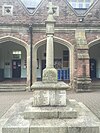
Monmouth is a town and community in Wales. It is situated where the River Monnow joins the River Wye, two miles from the Wales–England border. Monmouth is 30 miles (50 km) northeast of Cardiff, and 113 miles (182 km) west of London. It is within the Monmouthshire local authority, and the parliamentary constituency of Monmouth. The population in the 2011 census was 10,508, rising from 8,877 in 2001. Monmouth is the historic county town of Monmouthshire although Abergavenny is now the county town.

Monnow Bridge, in Monmouth, Wales, is the only remaining fortified river bridge in Great Britain with its gate tower standing on the bridge. Such bridge towers were common across Europe from medieval times, but many were destroyed due to urban expansion, diminishing defensive requirements and the increasing demands of traffic and trade. The historical and architectural importance of the bridge and its rarity are reflected in its status as a scheduled monument and a Grade I listed building. The bridge crosses the River Monnow 500 metres (1,600 ft) above its confluence with the River Wye.

Monmouth School for Boys is a public school for boys in Monmouth, Wales. The school was founded in 1614 with a bequest from William Jones, a successful merchant and trader. The School is run as a trust, the William Jones's Schools Foundation, by the Worshipful Company of Haberdashers, one of the livery companies, and has close links to its sister school, Haberdashers' Monmouth School for Girls. In 2018, the Haberdashers renamed their group of schools in the town, the Monmouth Schools, and made corresponding changes to the names of the boys' and girls' schools.
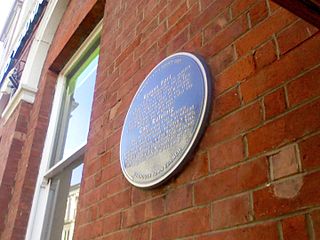
Blestium was a small fort and iron working centre in the Roman province of Britannia Superior, part of Roman Britain. It has been identified with the site of the later town of Monmouth in south east Wales, located adjoining the confluence of the River Monnow with the River Wye. A plaque on the local bank records its position.

Wyesham is a village and electoral ward in Monmouthshire, Wales. It is located less than one mile east of Monmouth, on the opposite side of the River Wye.

The Kymin, is a hill overlooking Monmouth, in Monmouthshire, Wales. It is located approximately one mile east of Monmouth, on the eastern side of the River Wye and adjacent to the border with the Forest of Dean and England. The summit of the hill, about 800 feet above sea level, is known for its neo-classical monuments, the Roundhouse and the Naval Temple, built between 1794 and 1800. It is registered on the Cadw/ICOMOS Register of Parks and Gardens of Special Historic Interest in Wales. The site is within a designated Area of Outstanding Natural Beauty (AONB) and is owned by the National Trust.
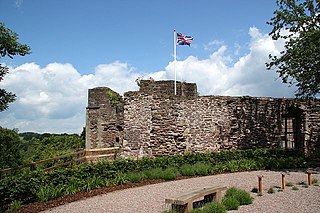
Monmouth Castle is a castle close to the centre of the town of Monmouth, the county town of Monmouthshire, on a hill above the River Monnow in south-east Wales.

The Monmouth Museum, alternatively known as The Nelson Museum and Local History Centre, is a museum in Monmouth, Monmouthshire, south east Wales. It features a collection of artifacts associated with Admiral Horatio Nelson. The museum is located in the old Market Hall in the town centre.
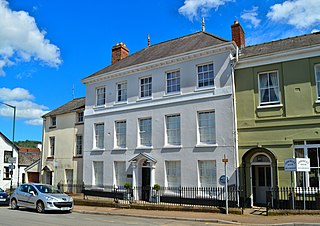
The Dispensary is a Georgian town house which is fairly typical of many town-centre houses in Monmouth, Wales, dating from the mid 18th century, but with early 19th-century additions. It stands in St James Square, opposite the Catalpa tree. The building was listed at Grade II on 27 June 1952.

St Mary's Priory Church, in Whitecross Street, Monmouth, Monmouthshire, Wales, is an Anglican church founded as a Benedictine priory in 1075. The current church dates mostly from the 18th and 19th centuries. It was designated a Grade II* listed building in 1952. It is one of 24 buildings on the Monmouth Heritage Trail.

The Mayor of Monmouth is an elected position given to a town councillor in Monmouth in Wales. The position dates back about 750 years.
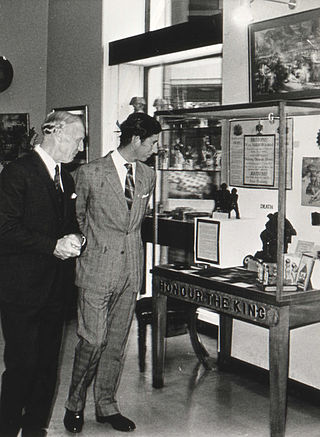
Keith Edward Kissack MBE was a British schoolteacher and historian. He is notable for his many publications on the history of Monmouth and Monmouthshire.

Overmonnow is a suburb of the town of Monmouth, in Wales, which is located to the west of the River Monnow and the Monnow Bridge. It developed in the Middle Ages, when it was protected by a defensive ditch, the Clawdd-du or "Black Dyke", the remains of which are now protected as an ancient monument. In later centuries the area became known as "Little Monmouth" or "Cappers' Town".

Charles Heath was a printer and writer who became a leading radical in Monmouth. He was twice elected Mayor of Monmouth.

Vauxhall Fields, also known as Vauxhall Meadows, are water meadows to the northwest of Monmouth town centre, Wales. The River Monnow borders the meadows on two sides. The meadows have generally remained free of development. The area has been prone to flooding on many occasions over the years.

The War Memorial of the Royal Monmouthshire Royal Engineers commemorates the soldiers who died in World War I and World War II.
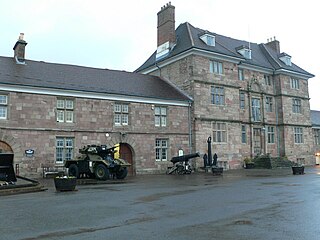
The Monmouth Regimental Museum is located on Castle Hill in Monmouth, Monmouthshire, Wales. The museum is in a wing of Great Castle House, a listed building on the Monmouth Heritage Trail. The focus of most of the museum's exhibits is the most senior regiment in the British Territorial Army, the Royal Monmouthshire Royal Engineers. Great Castle House is home to the Royal Monmouthshire Royal Engineers, and the museum maintains the records of the regiment.
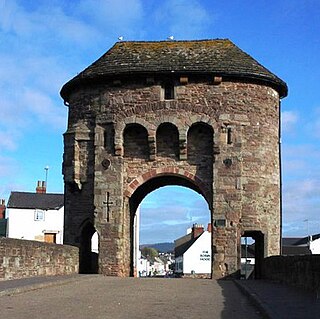
The Monmouth town walls and defences comprise the defensive system of town walls and gates built in Monmouth, Wales between 1297 and the early part of the following century. Wye Bridge Gate, East Gate, Monk's Gate, and Monnow Bridge Gate were access points to the town. West Gate, across Monnow Street, also provided access. Only the Monnow Bridge Gatehouse survives intact, albeit in a substantially modified version from the original.

St Cenedlon's is a parish church in the village of Rockfield, Monmouthshire, Wales. The dedication to St Cenedlon is unusual and the history of the saint is obscure. Some sources suggest that she was a daughter of Brychan king of Brycheiniog while others identify her as the wife of King Arthfael ab Ithel, king of Glywysing. The existing church dates from the Middle Ages but only the tower remains from that period. After the English Reformation, the surrounding area of north Monmouthshire became a refuge for Catholics and Matthew Pritchard (1669-1750), Roman Catholic bishop and Vicar Apostolic of the Western District is buried at the church. By the mid-19th century the church was in ruins and a complete reconstruction was undertaken by the ecclesiastical architects John Pollard Seddon and John Prichard in around 1860. St Cenedlon's is an active parish church in the Diocese of Monmouth. It is designated by Cadw as a Grade II listed building.

The Inglis Bridge, Monmouth, Wales crosses the River Monnow linking Vauxhall Fields and the suburb of Osbaston. Designed by, and named after, Charles Inglis, the bridge was constructed in 1931 and refurbished in 1988. It is a Mark II model of an Inglis bridge, and the only known example in Britain of such a bridge still in public use. Access is now limited to pedestrians, vehicular use being prohibited in 2018 on safety grounds. The bridge is a Grade II listed structure.

